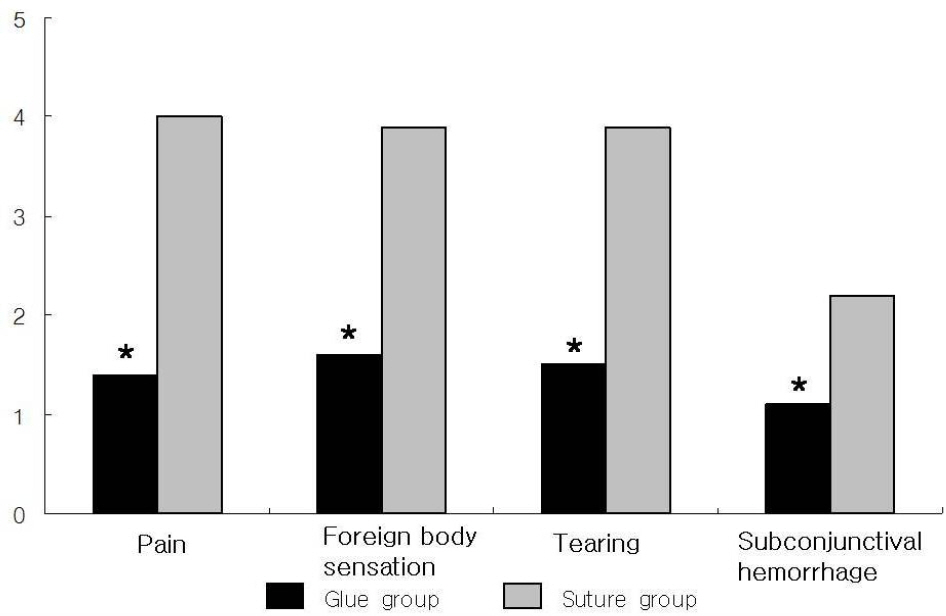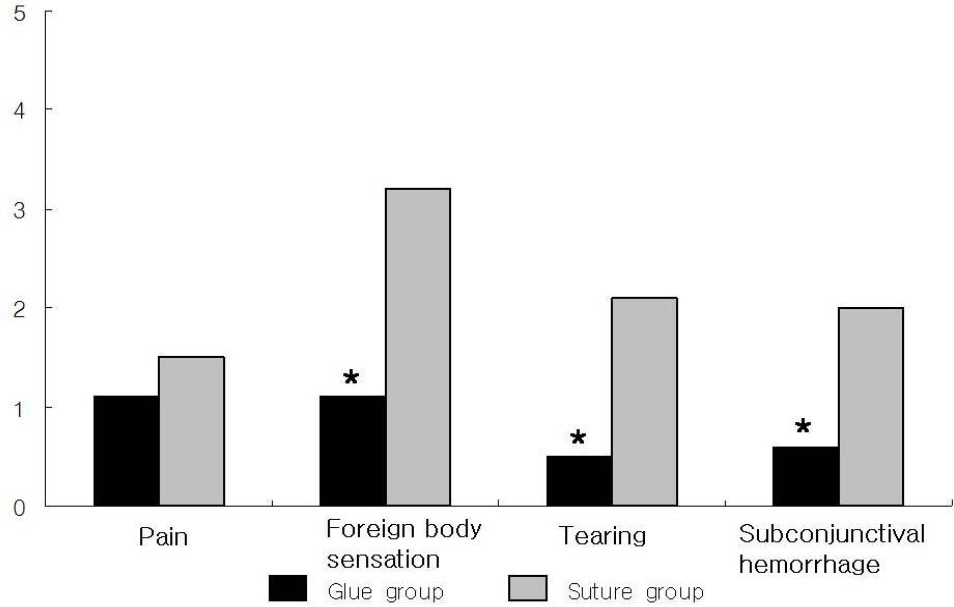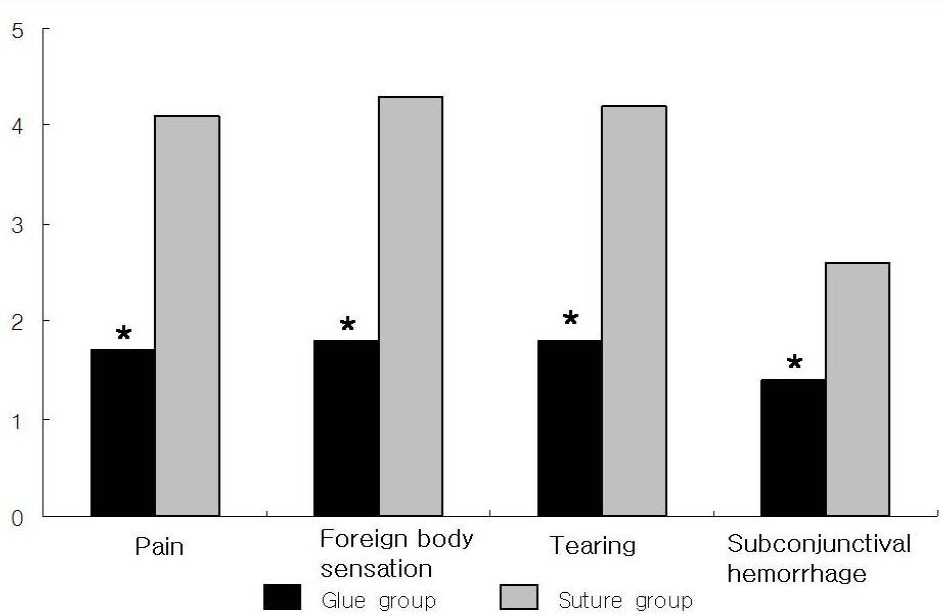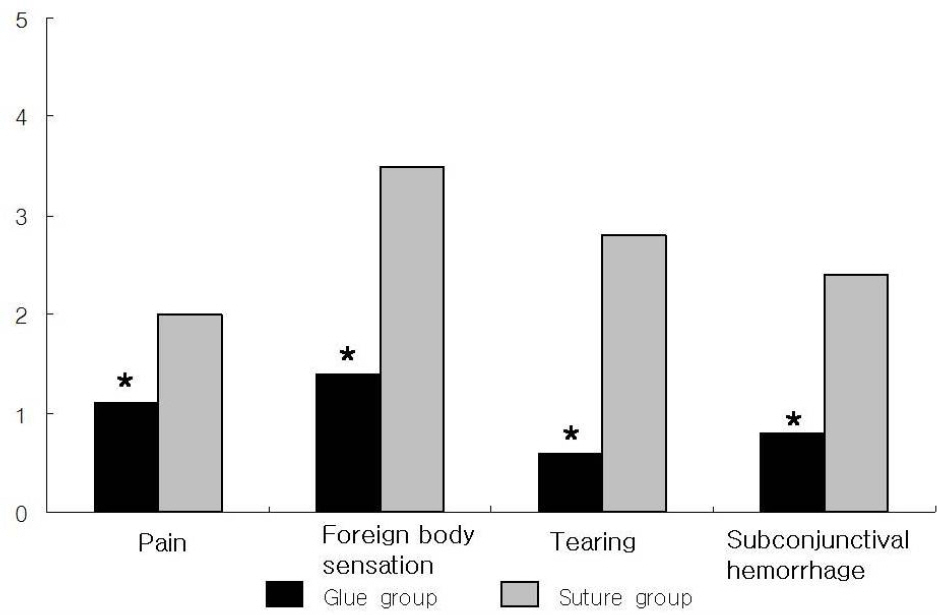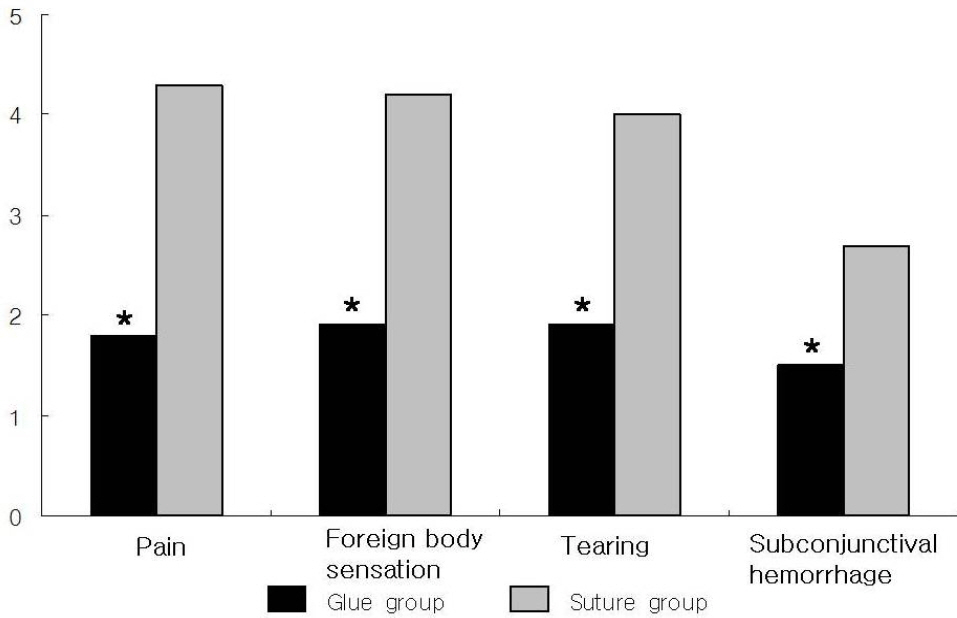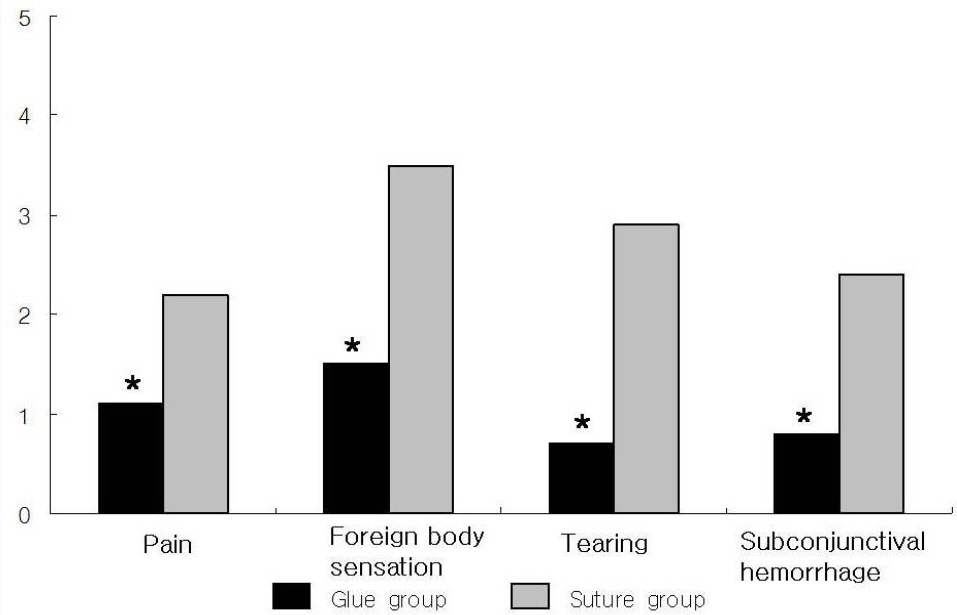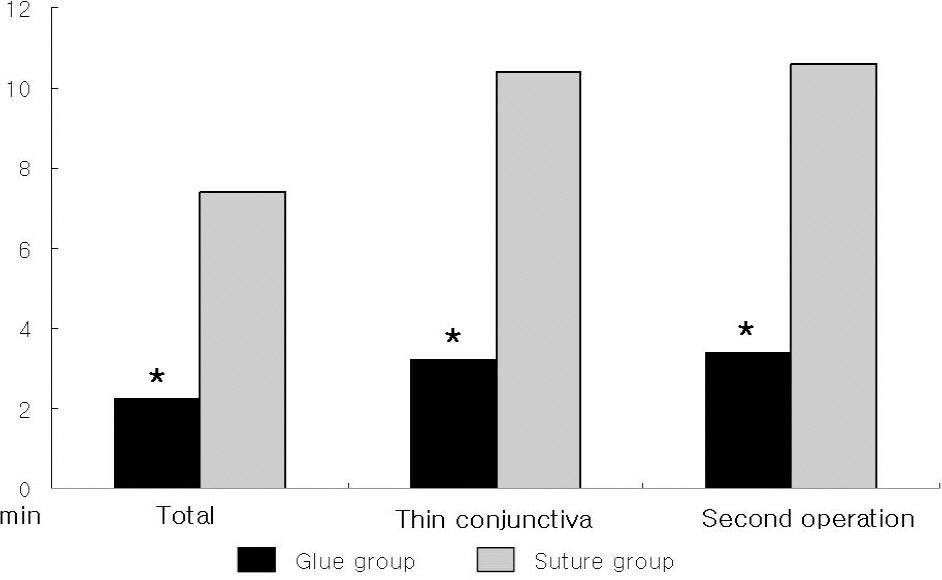J Korean Ophthalmol Soc.
2008 Aug;49(8):1283-1288. 10.3341/jkos.2008.49.8.1283.
Fibrin Glue for Conjunctival Closure in Pars Plana Vitrectomy
- Affiliations
-
- 1Department of Ophthalmology, College of Medicine, Chungnam National University, Daejeon, Korea. kimjy@cnu.ac.kr
- 2Chungnam National University Research Institute for Medical Sciences, Daejeon, Korea.
- KMID: 2211733
- DOI: http://doi.org/10.3341/jkos.2008.49.8.1283
Abstract
-
PURPOSE: To investigate the efficacy of fibrin glue for conjunctival closure in vitrectomy.
METHODS
Two hundred five eyes of 200 patients who underwent conjunctival closure for vitrectomy with a minimum follow-up period of six months were evlauated. Postopertive pain, foreign body sensation, tearing, subconjunctival hemorrhage, surgery time and complication were evaluated prospectively in 105 eyes of 100 patients undergoing surgery with fibrin glue, and in 100 eyes of 100 patients undergoing surgery with sutures.
RESULTS
One day postoperatively, pain scores (p< 0.05), foreign body sensation (p< 0.05), tearing (p< 0.05), and subconjunctival hemorrhage (p< 0.05) were significantly lower in the fibrin glue group than in the suture group. One week postoperatively, the scores of foreign body sensation (p< 0.05), tearing (p< 0.05), subconjunctival hemorrhage (p< 0.05) were significantly lower in the fibrin glue group than in the suture group. The mean surgery time in the fibrin glue group (2.2+/-0.5 minutes) was significantly shorter than that in the sutures group (7.4+/-0.6 minutes) (p< 0.05).
CONCLUSIONS
The Use of fibrin glue for conjunctival closure in vitrectomy can reduce postoperative discomfort and surgical time. It is especially useful for a second operation or for cases with a thin, atrophic conjunctiva.
Keyword
MeSH Terms
Figure
Cited by 1 articles
-
The Usefulness of Fibrinogen-Thrombin Adhesives for Management of Conjunctival Closure in Scleral Buckling Operation
Kyung Soo Park, Sang Woo Kim, Je Moon Woo
J Korean Ophthalmol Soc. 2013;54(12):1832-1837. doi: 10.3341/jkos.2013.54.12.1832.
Reference
-
References
1. Machemer R, Buettner H, Norton EW, Parel JM. Vitrectomy: a pars plana approach. Trans Am Acad Ophthalmol Otolaryngol. 1971; 75:813–20.2. Zauberman H, Hemo I. Use of fibrin glue in ocular surgery. Ophthalmic Surg. 1988; 19:132–3.
Article3. Lagoutte FM, Gauthier L, Comte PR. A fibrin sealant for perforated and preperforated corneal ulcers. Br J Ophthalmol. 1989; 73:757–61.
Article4. Mandel MA. Closure of blepharoplasty incisions with autologous fibrin glue. Arch Ophthalmol. 1990; 108:842–4.
Article5. Bartley GB, McCaffrey TV. Cryoprecipitated fibrinogen (fibrin glue) in orbital surgery. Am J Ophthalmol. 1990; 109:227–8.
Article6. Kajiwara K. Repair of a leaking bleb with fibrin glue. Am J Ophthalmol. 1990; 109:599–601.
Article7. Alio JL, Mulet E, Sakla HF, Gobbi F. Efficacy of synthetic and biological bioadhesives in scleral tunnel phacoemulsification in eyes with high myopia. J Cataract Refract Surg. 1998; 24:983–8.8. Kaufman HE, Insler MS, Ibrahim-Elzembely HA, Kaufman SC. Human fibrin tissue adhesive for sutureless lamellar keratoplasty and scleral patch adhesion: a pilot study. Ophthalmology. 2003; 110:2168–72.9. Uy HS, Reyes JM, Flores JD, Lim-Bon-Siong R. Comparison of fibrin glue and sutures for attaching conjunctival autografts after pterygium excision. Ophthalmology. 2005; 112:667–71.
Article10. Yoon KC, Heo H, Jeong IY. The Use of Fibrin Glue for Conjunctival Autotransplantation in Pterygium. J Korean Ophthalmol Soc. 2006; 47:198–204.11. Cohen RA, McDonald MB. Fixation of conjunctival autografts with an organic tissue adhesive [letter]. Arch Ophthalmol. 1993; 111:1167–8.12. Koranyi G, Seregard S, Kopp ED. Cut and paste: a no suture, small incision approach to pterygium surgery. Br J Ophthalmol. 2004; 88:911–4.
Article13. Ordman LJ, Gillman T. Studies in the healing of cutaneous would. Arch Surg. 1996; 93:857–928.14. Calson AN, Wilhelmus KR. Giant papillary conjunctivitis associated with cyanoacryl glue. Am J Ophthalmol. 1987; 104:437–8.15. Yamada KM, Olden K. Fibronectin-adhesive glycoproteins of cell surface and blood. Nature. 1978; 275:179–84.16. Krzizok T. Fibrin glue for closing conjunctival wounds in ophthalmic surgery. Ophthalmologe. 2004; 101:1006–10.17. Radosevich M, Goubran HA, Burnouf T. Fibrin sealant: scientific rationale, production methods, properties, and current clinical use. Vox Sang. 1997; 72:133–43.
Article
- Full Text Links
- Actions
-
Cited
- CITED
-
- Close
- Share
- Similar articles
-
- The Usefulness of Fibrinogen-Thrombin Adhesives for Management of Conjunctival Closure in Scleral Buckling Operation
- Fibrin Sealant Injection for Control of Hemorrhage in Vitreous Surgery of Proliferative Diabetic Retinopathy
- Trabeculectomy Combined with Pars Plana Vitrectomy
- The Alteration of Accommodative Power after Scleral Buckling and Pars Plana Vitrectomy
- After-Cataract Following Pars Plana Lensectomy and PCL Implantation


